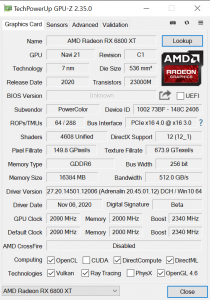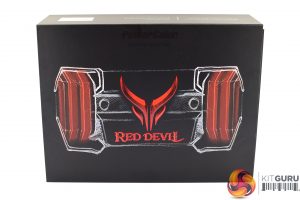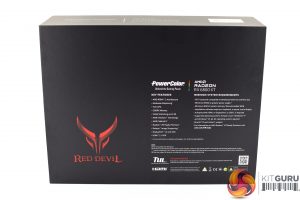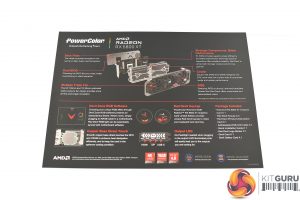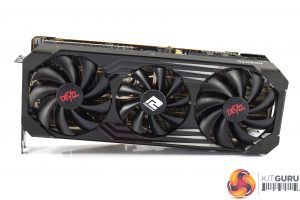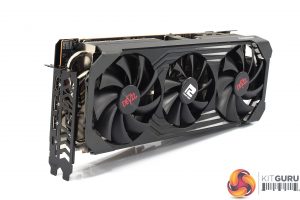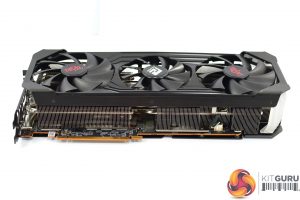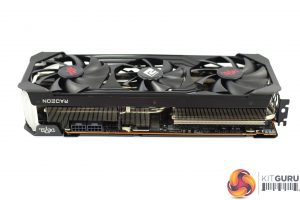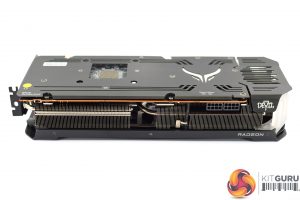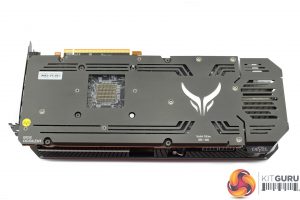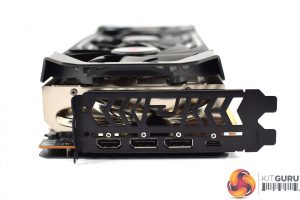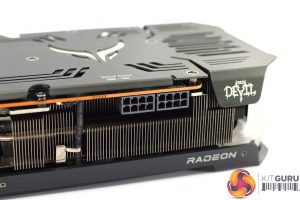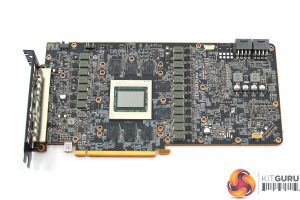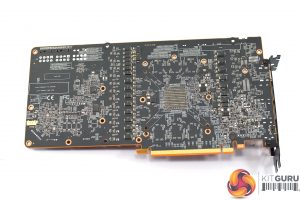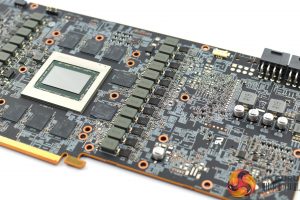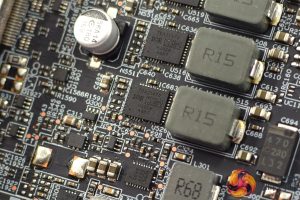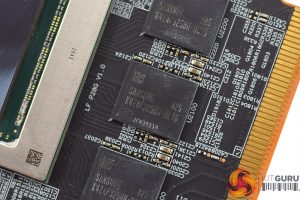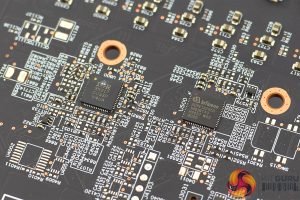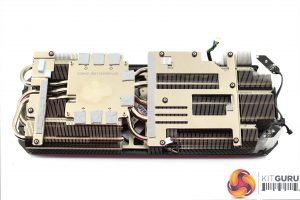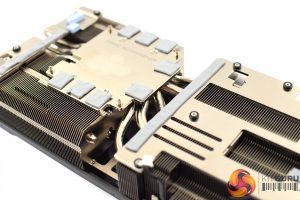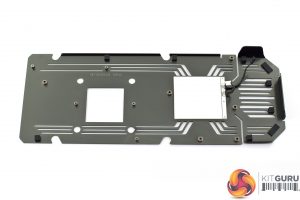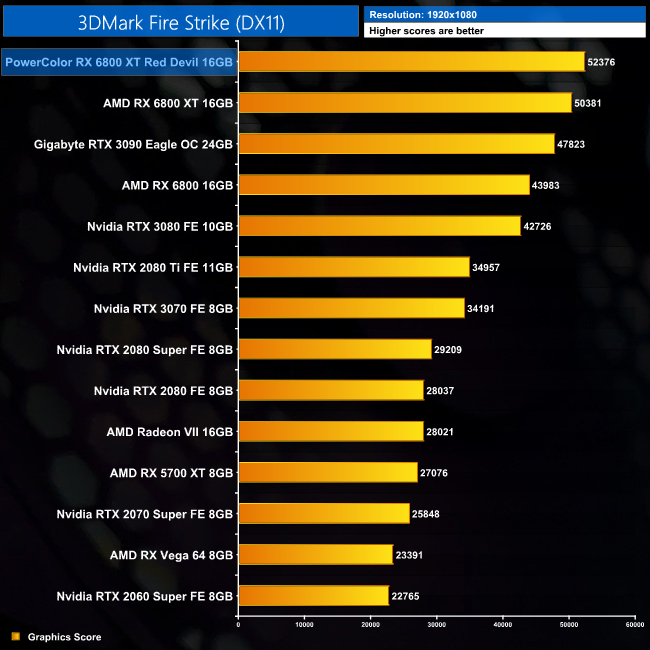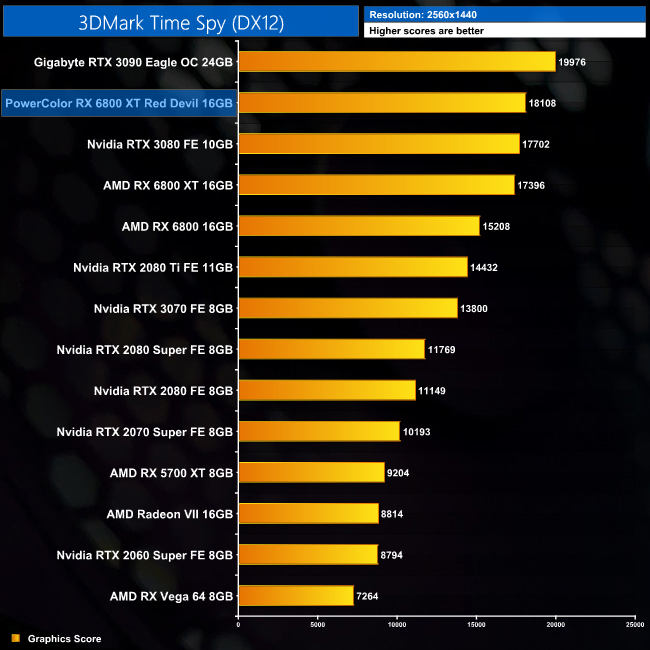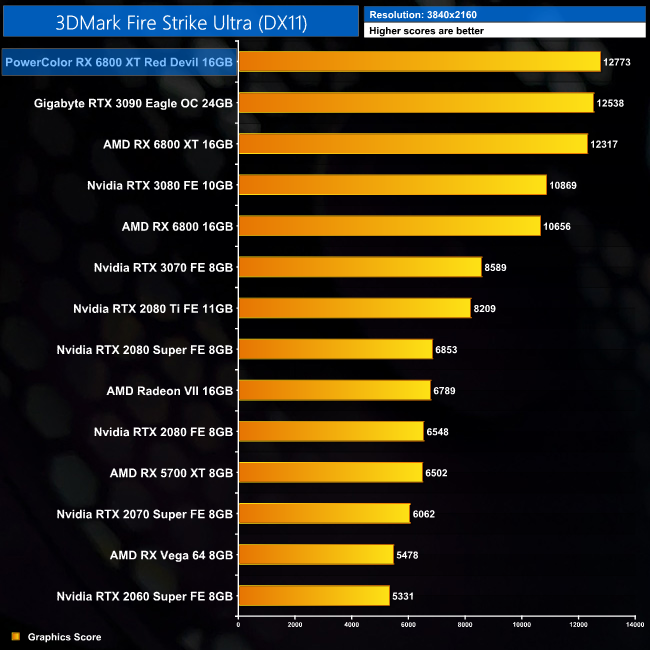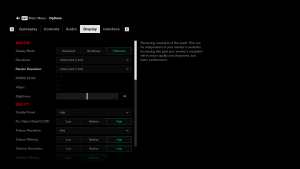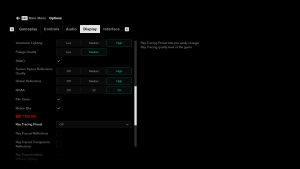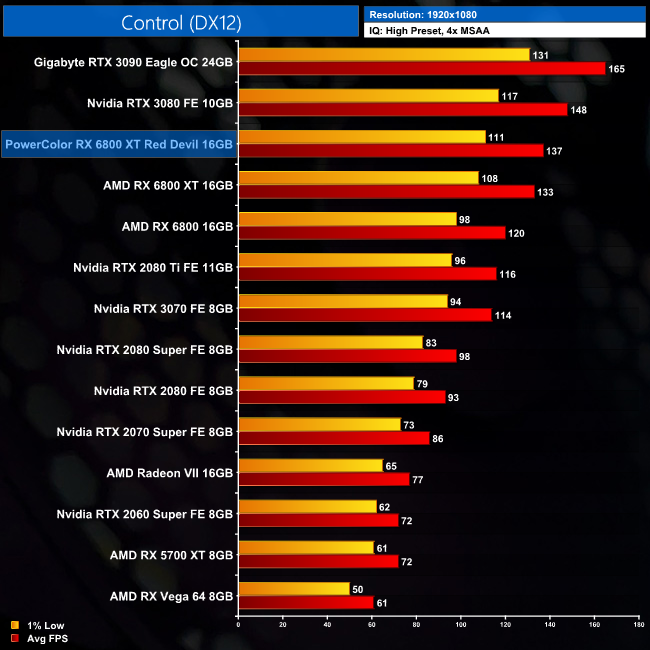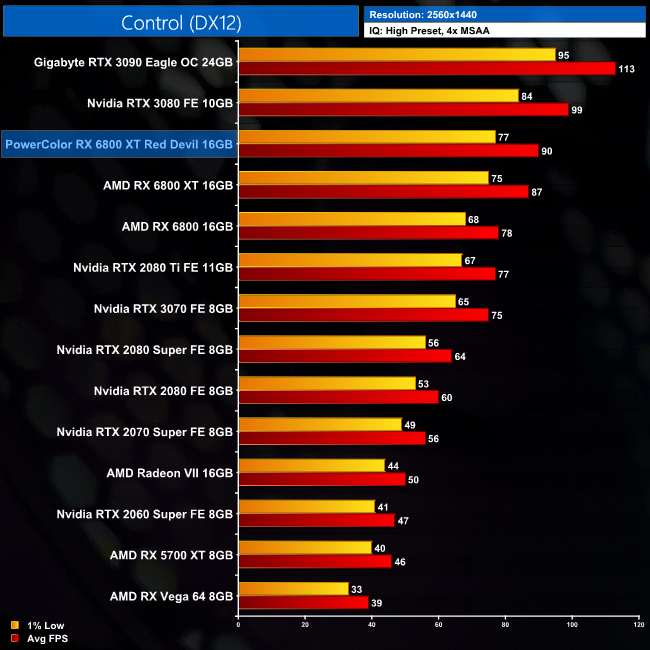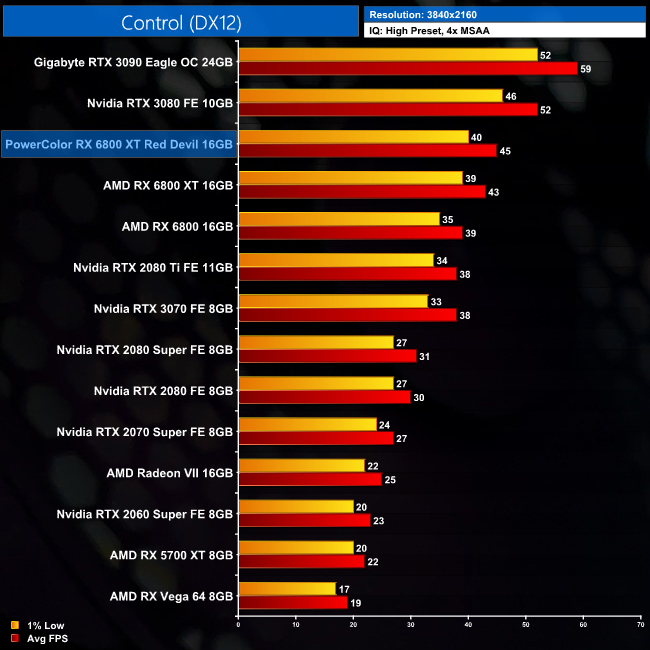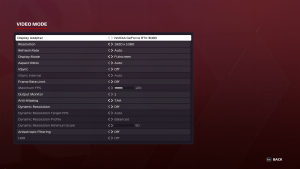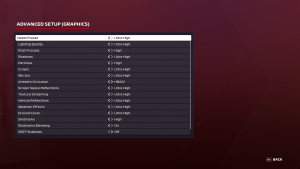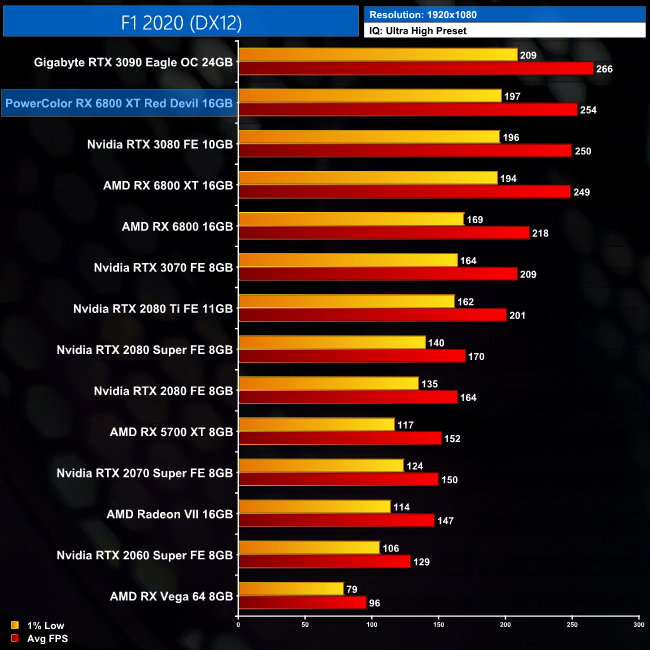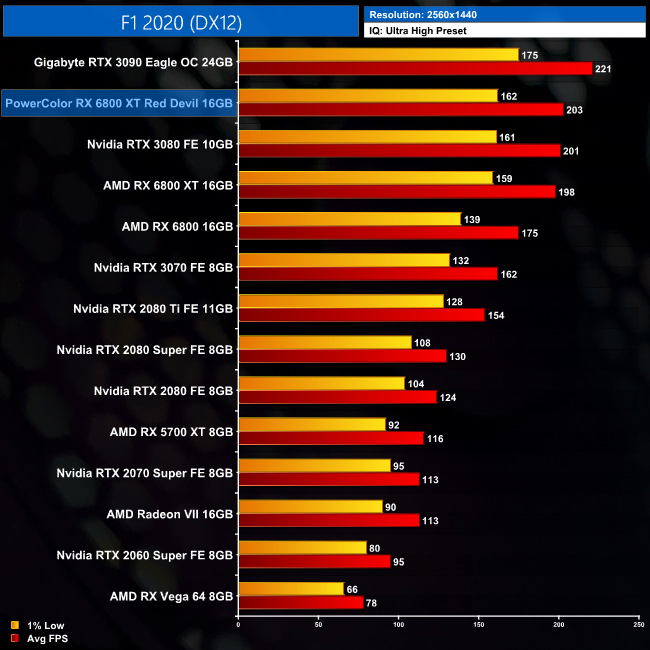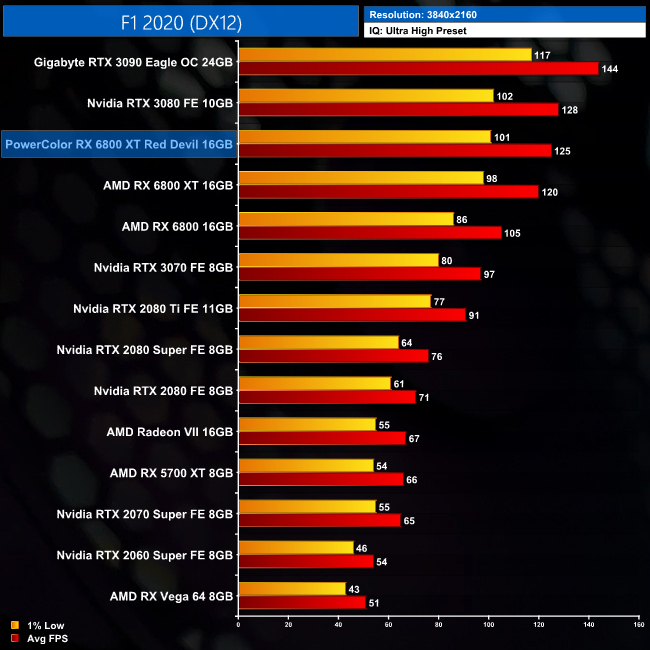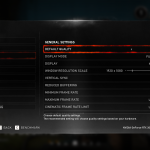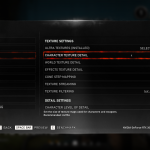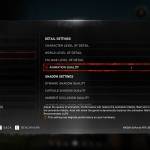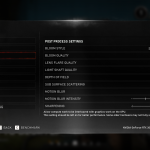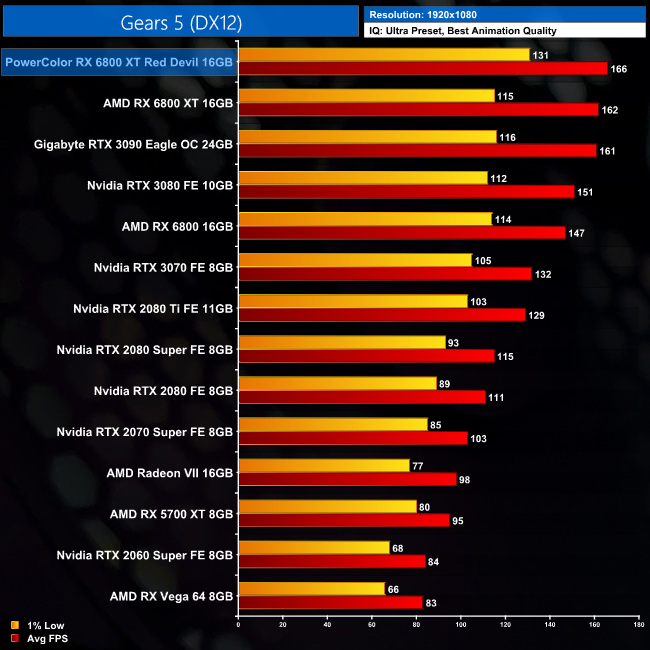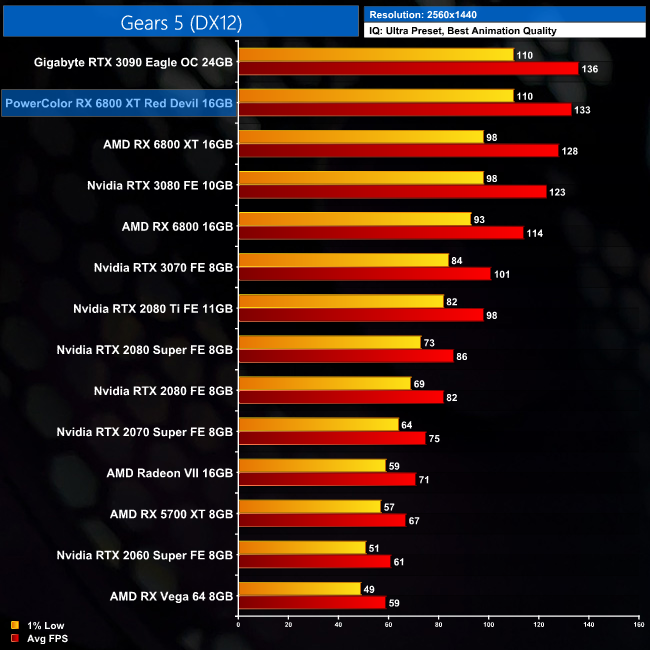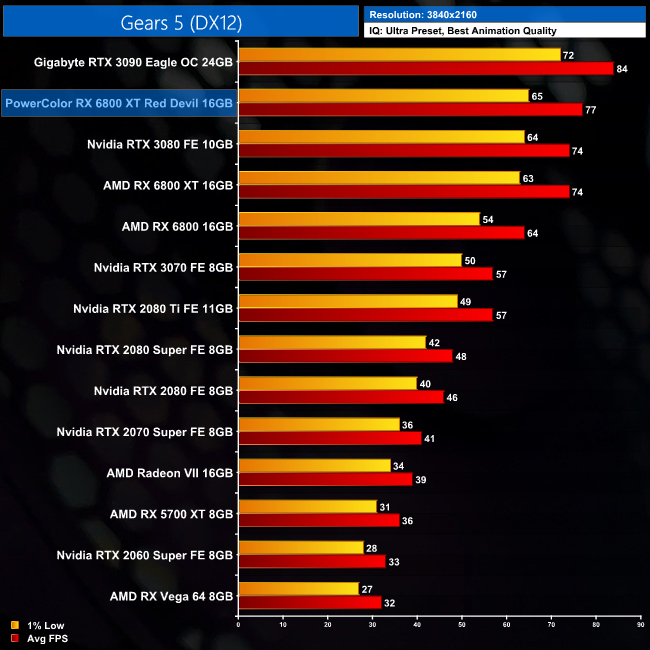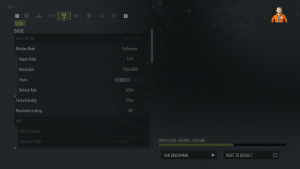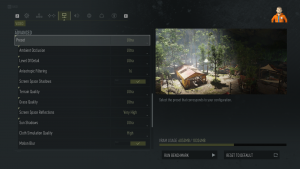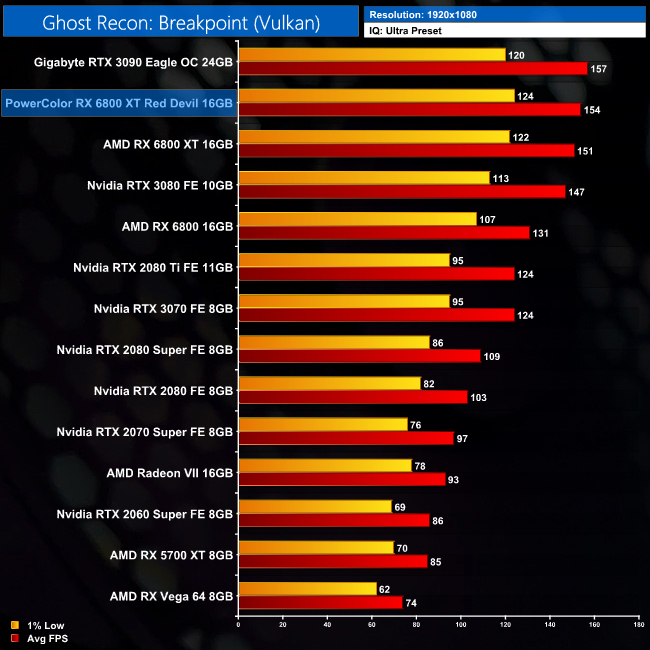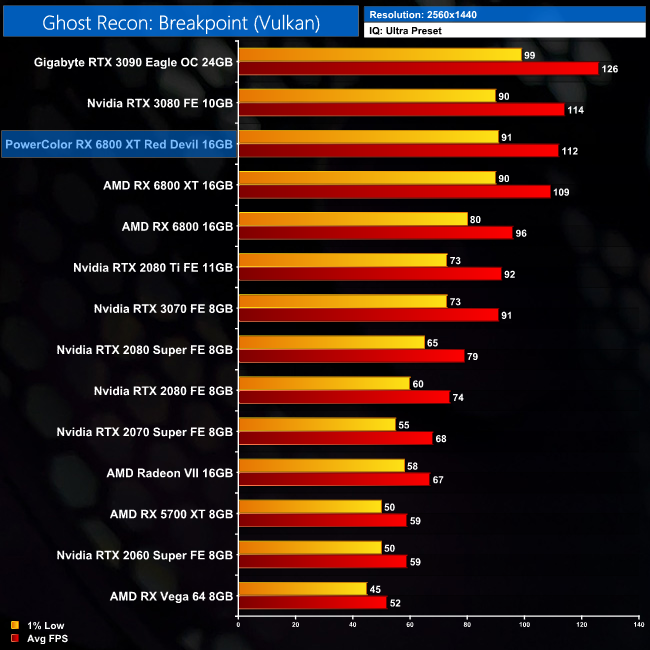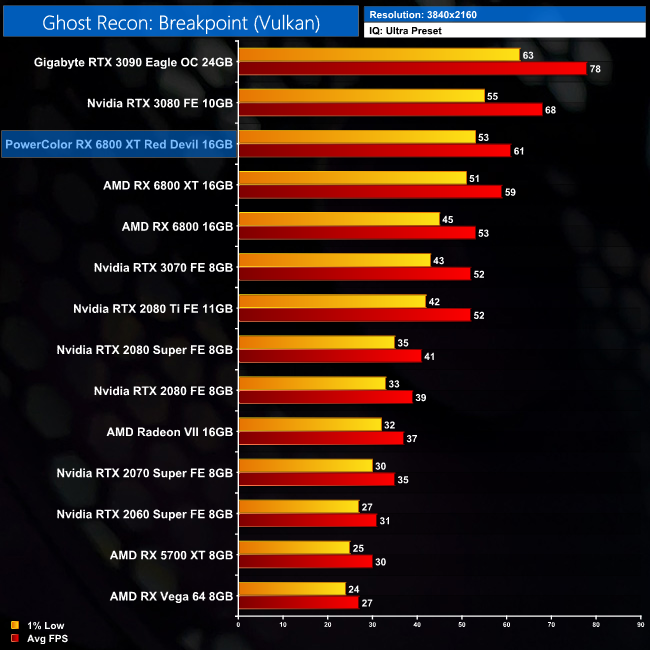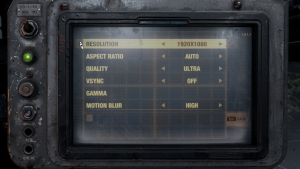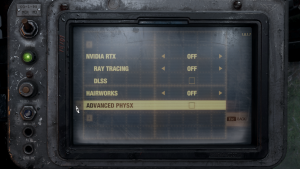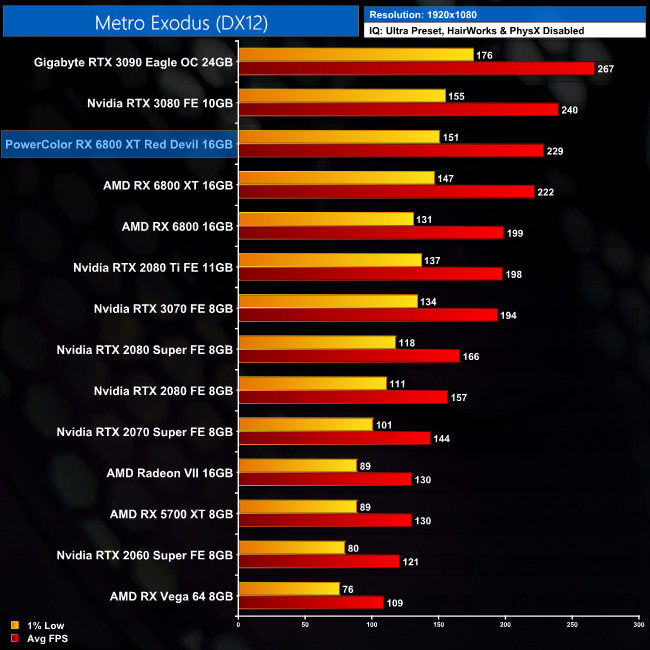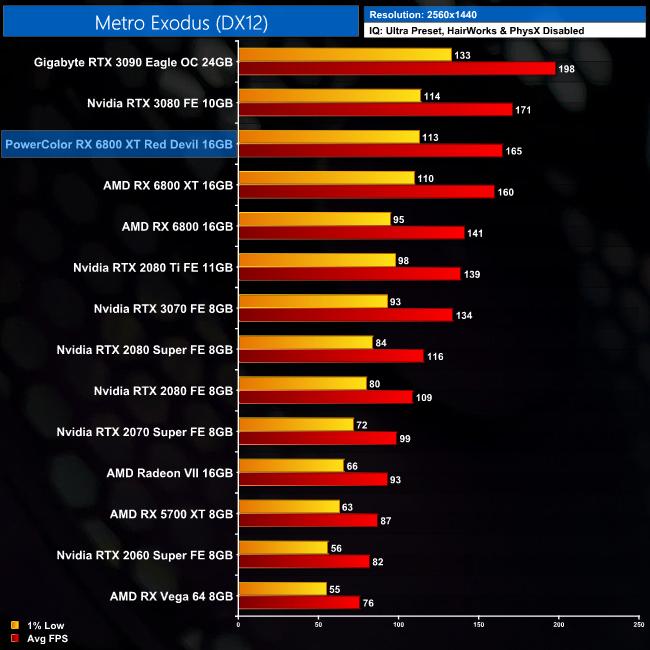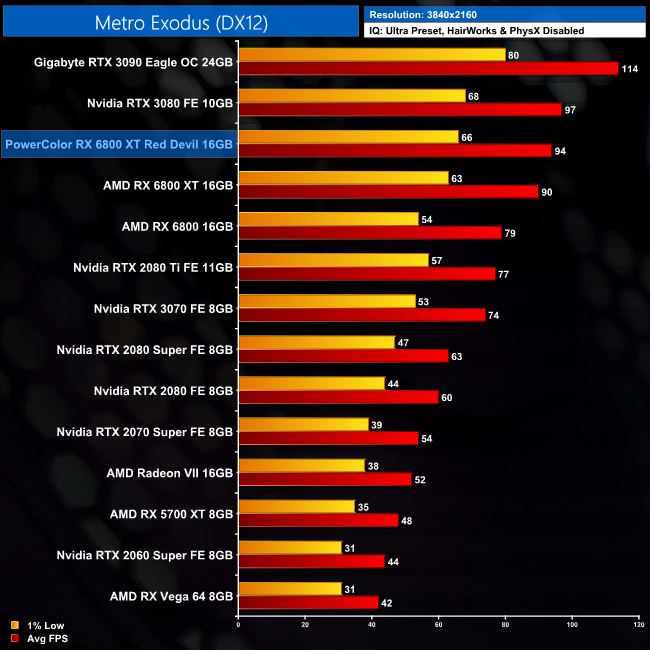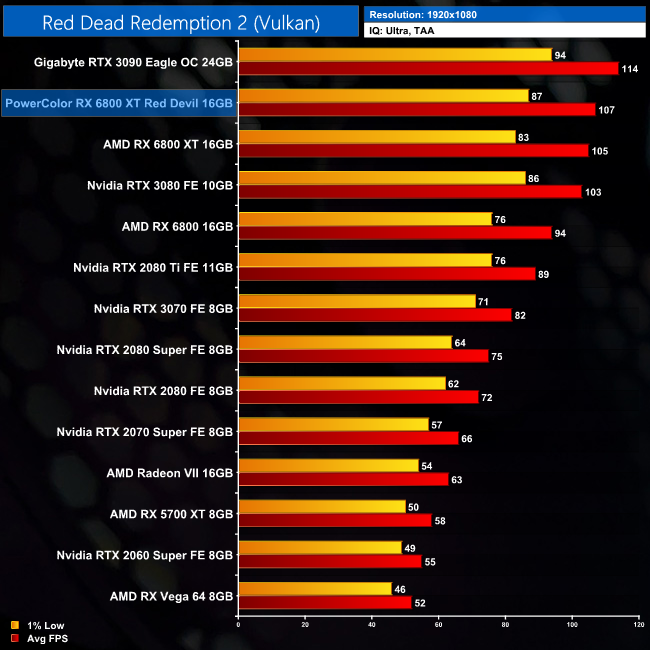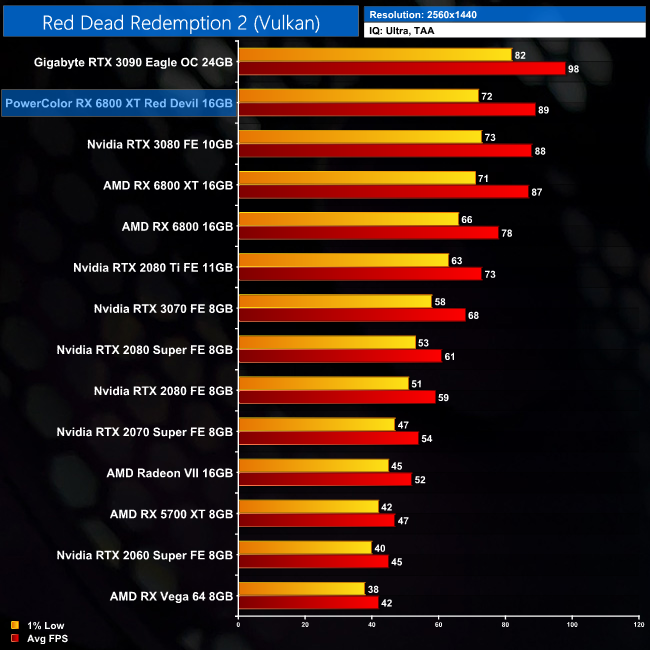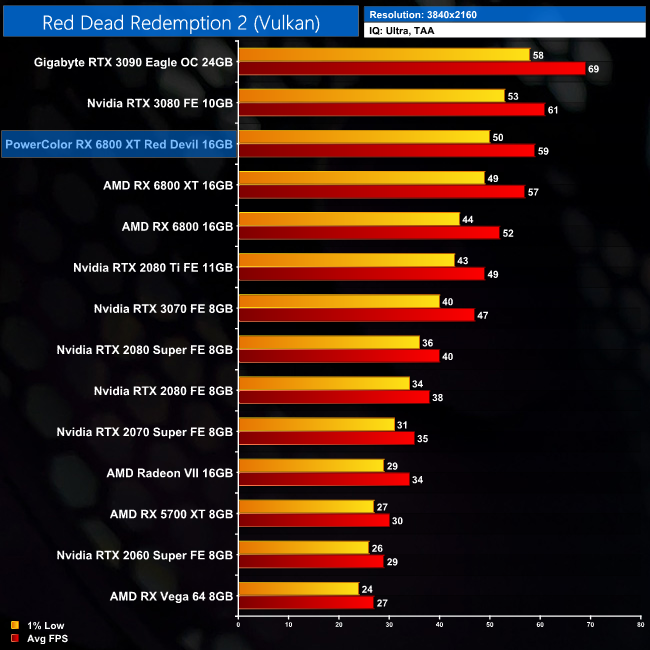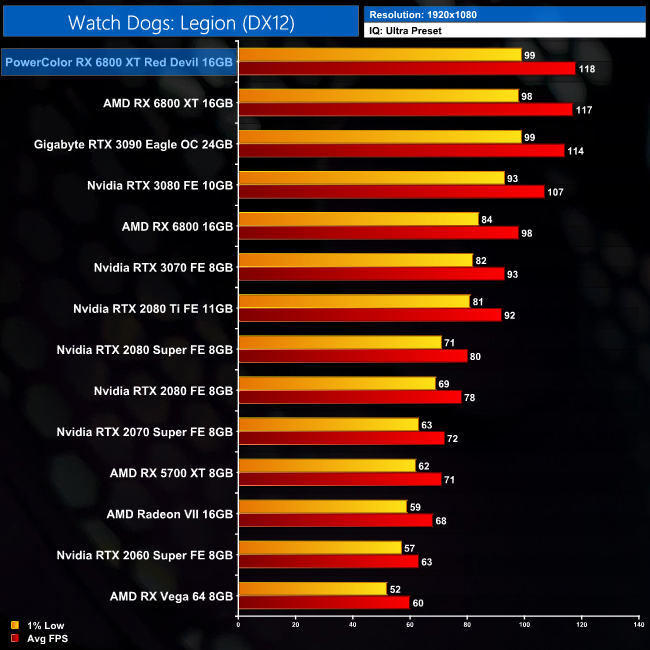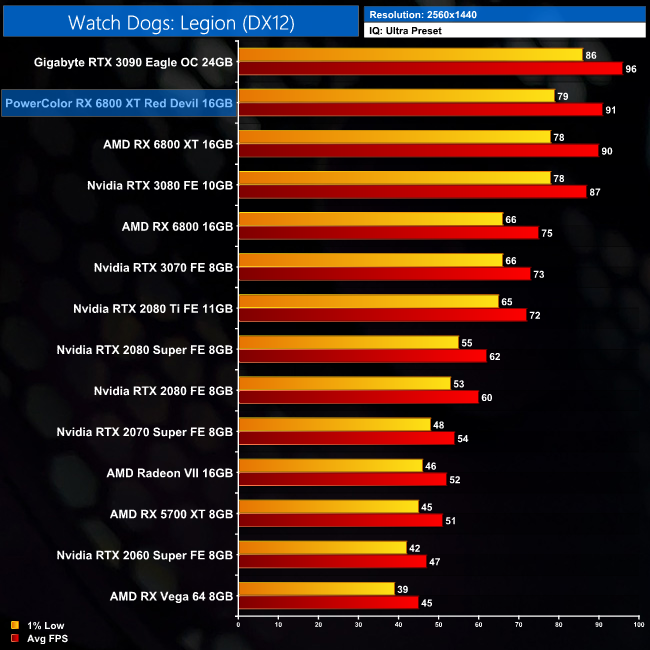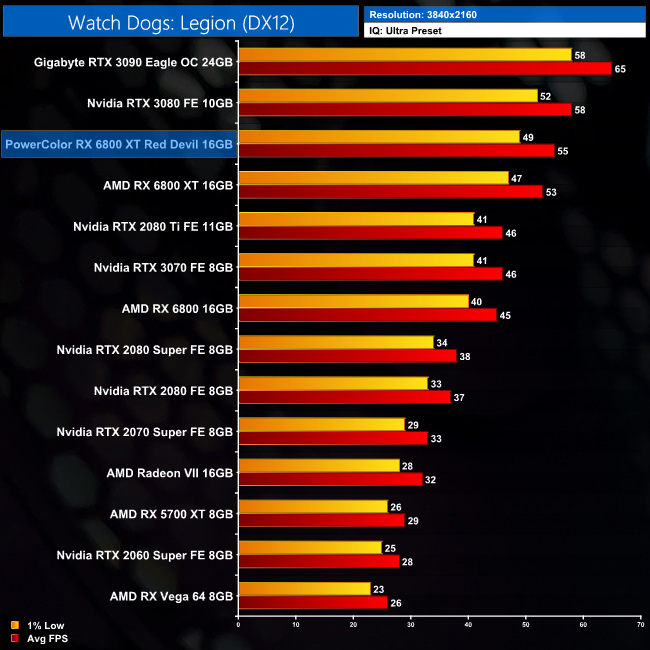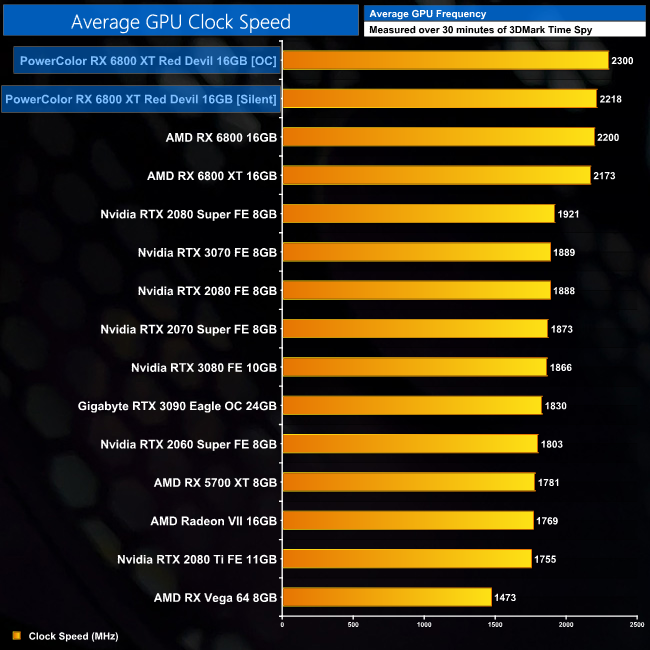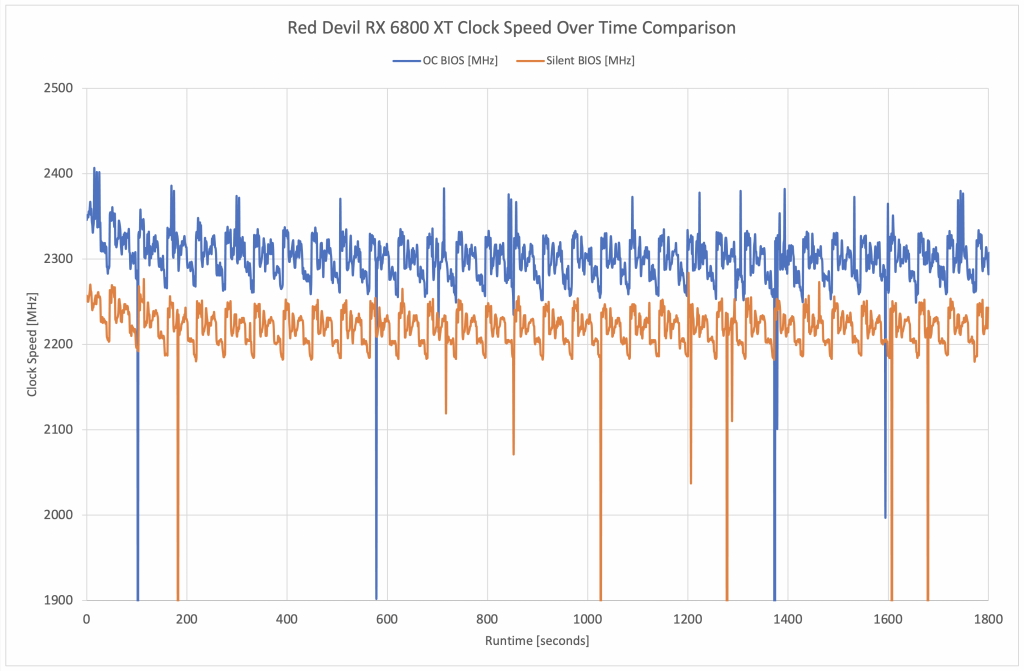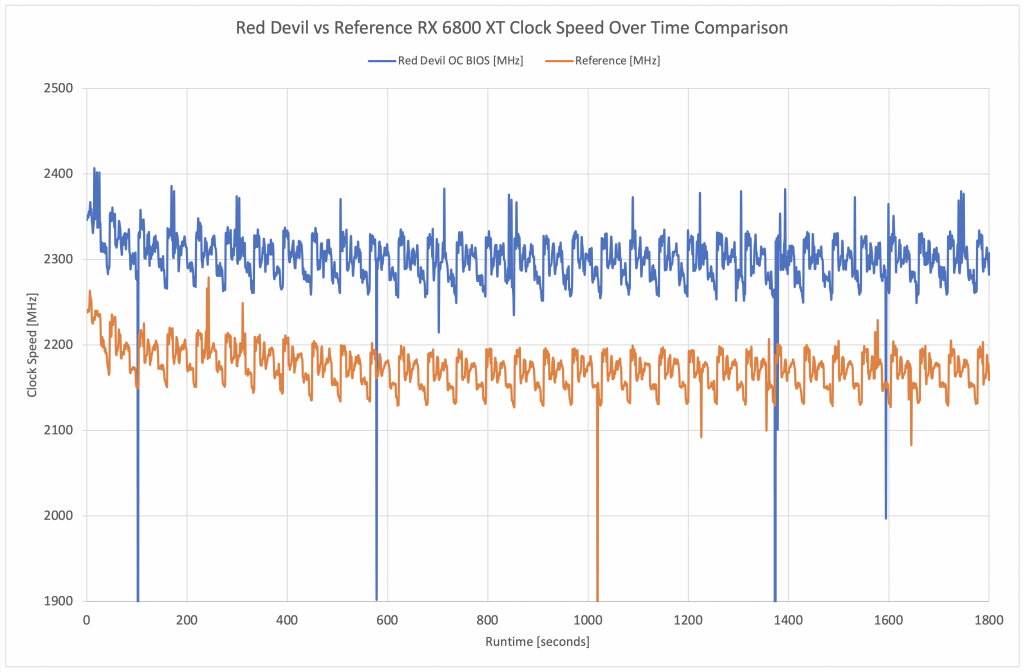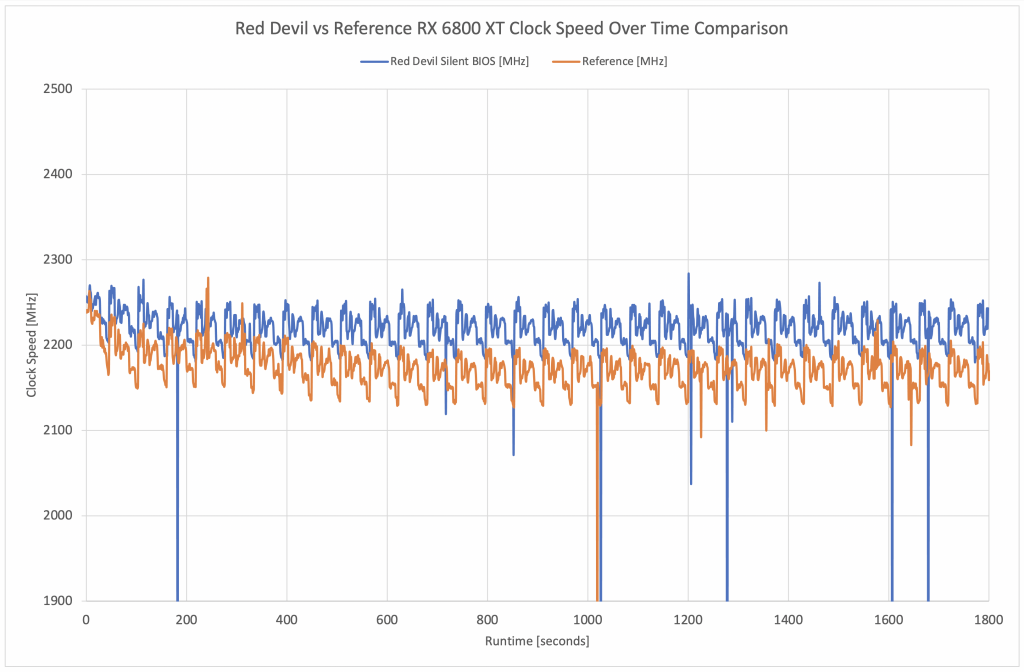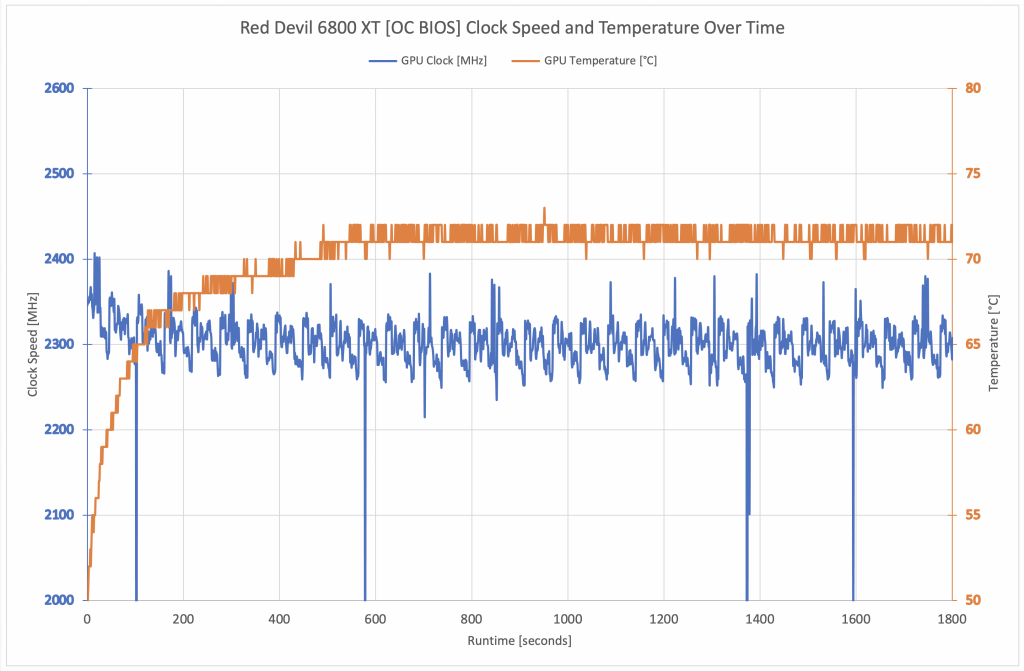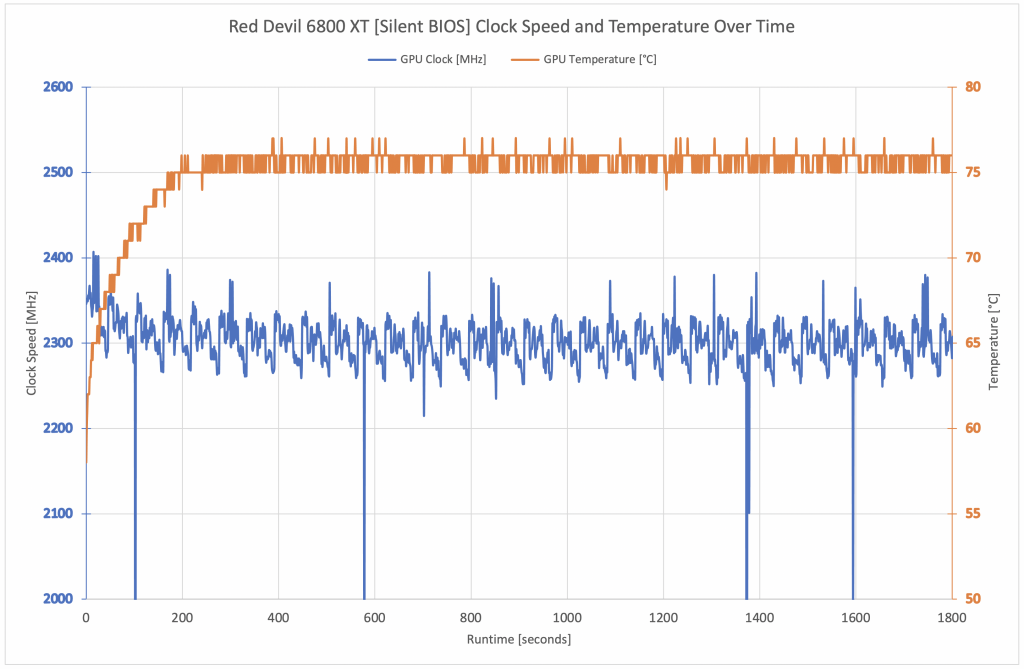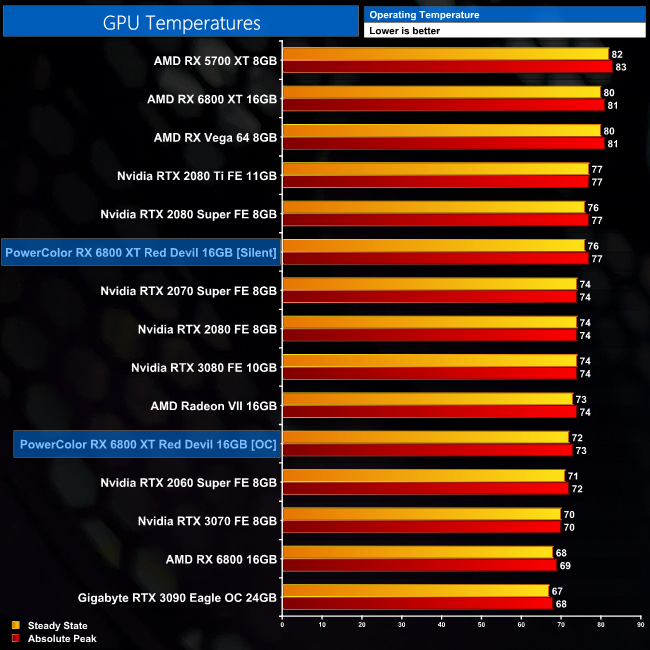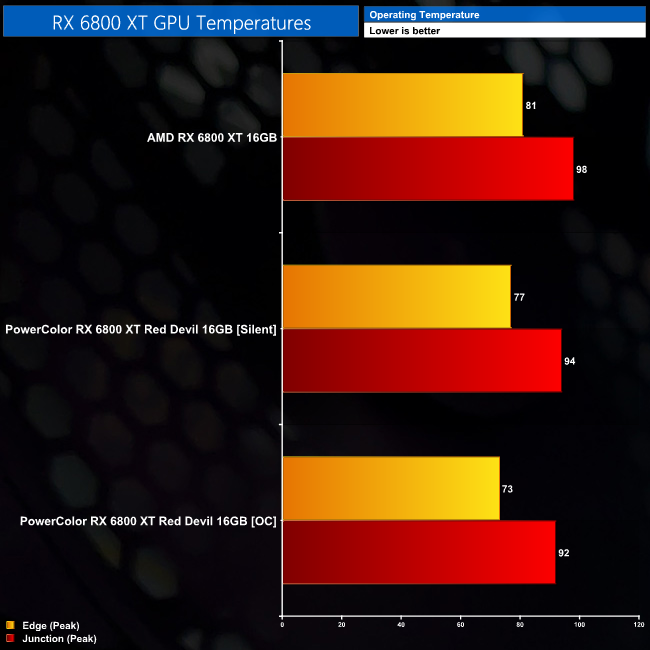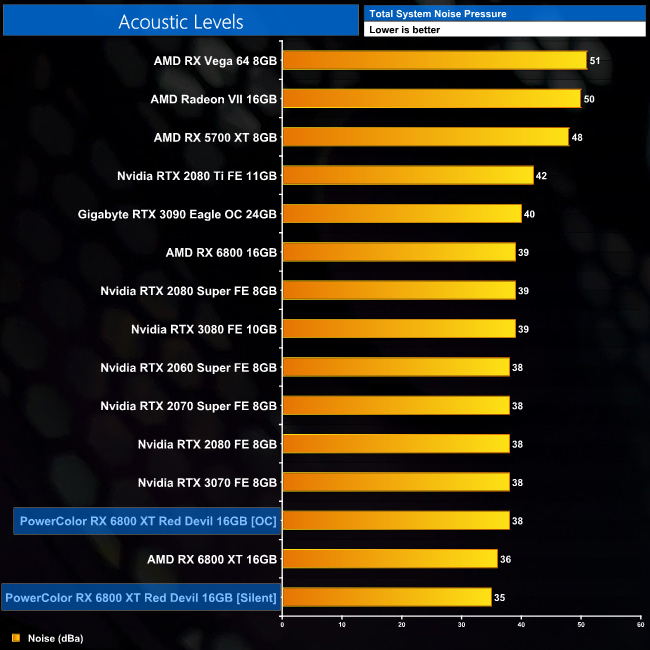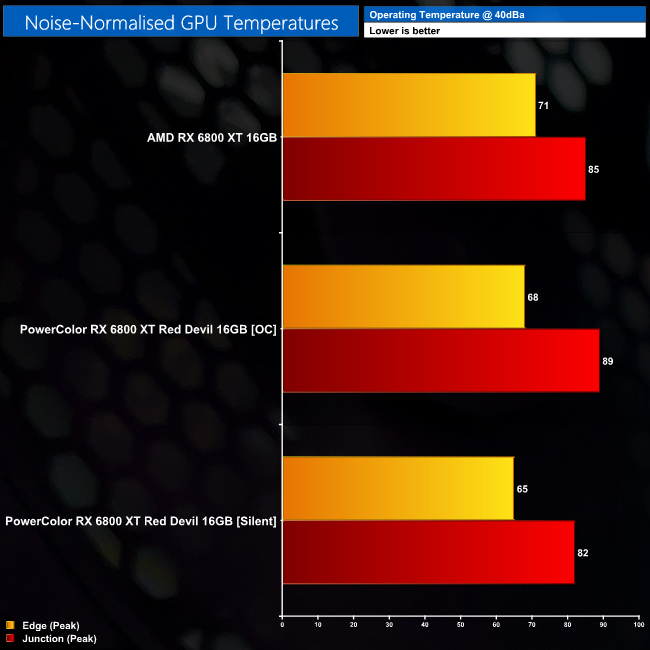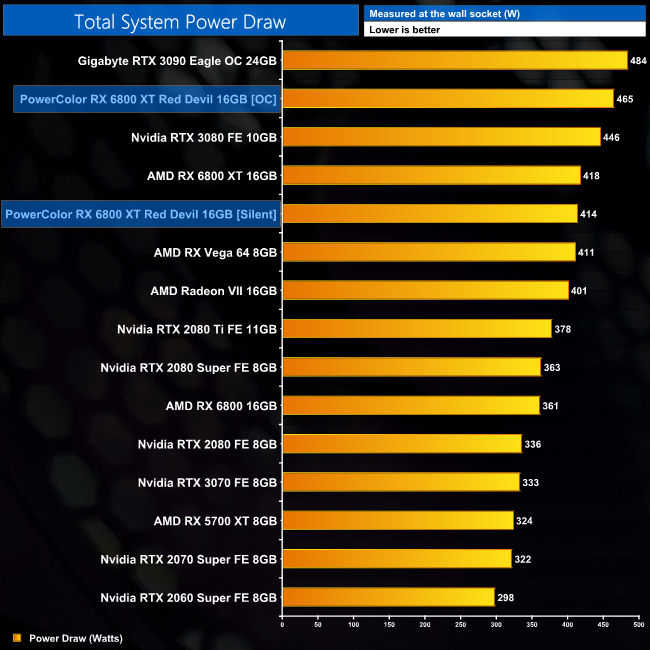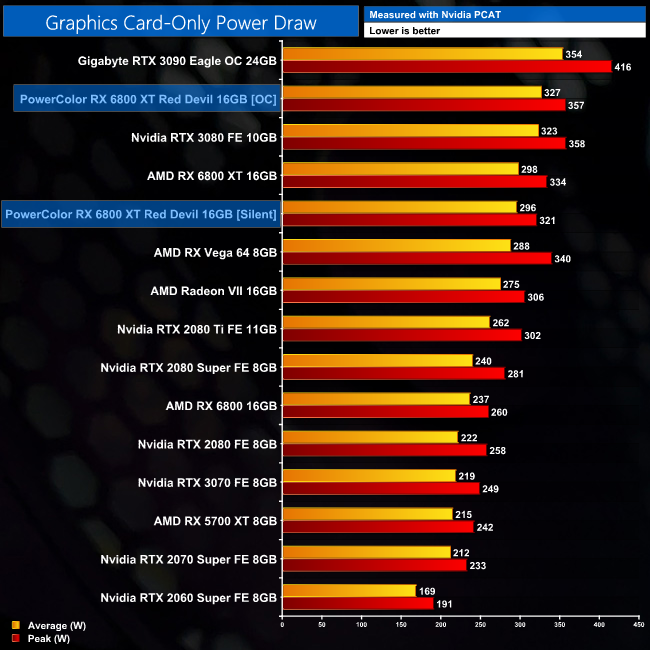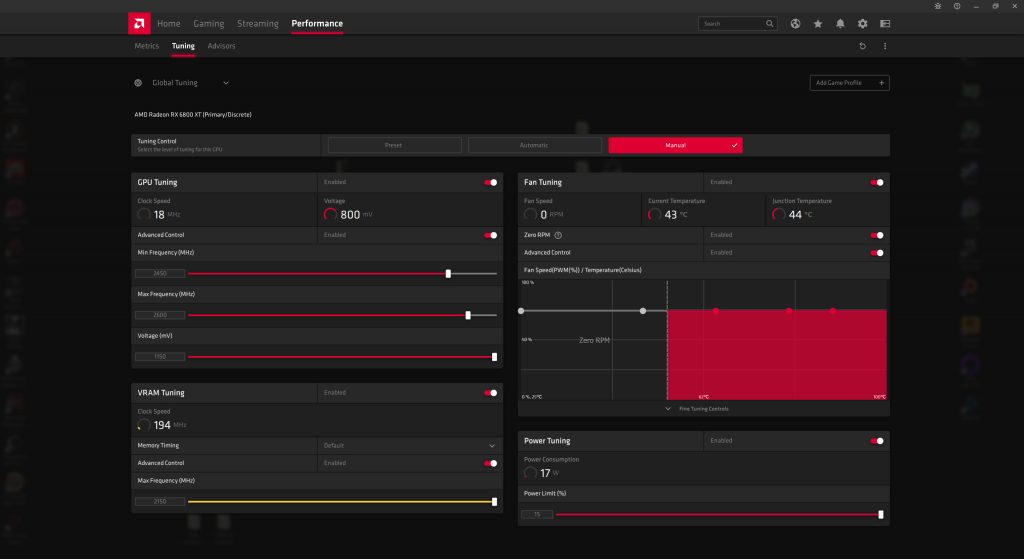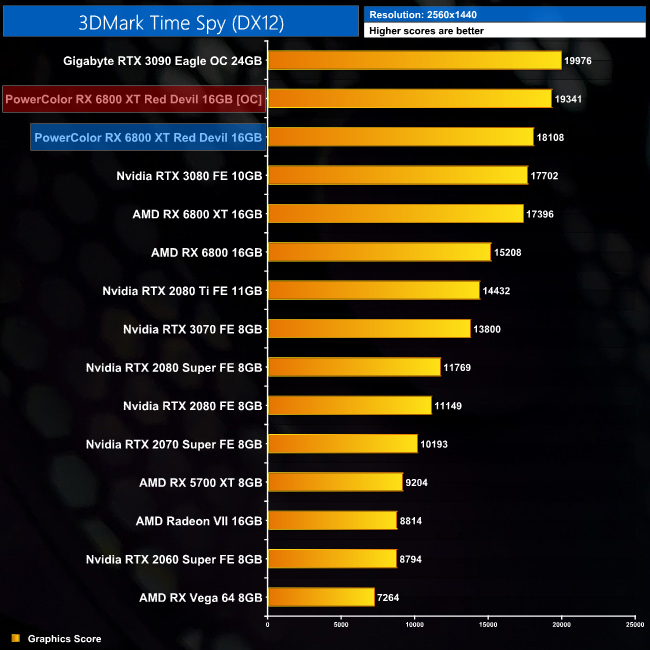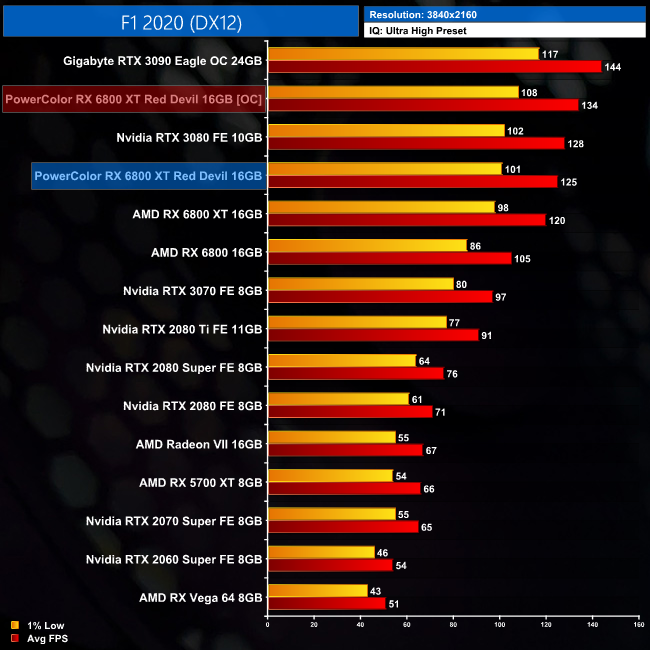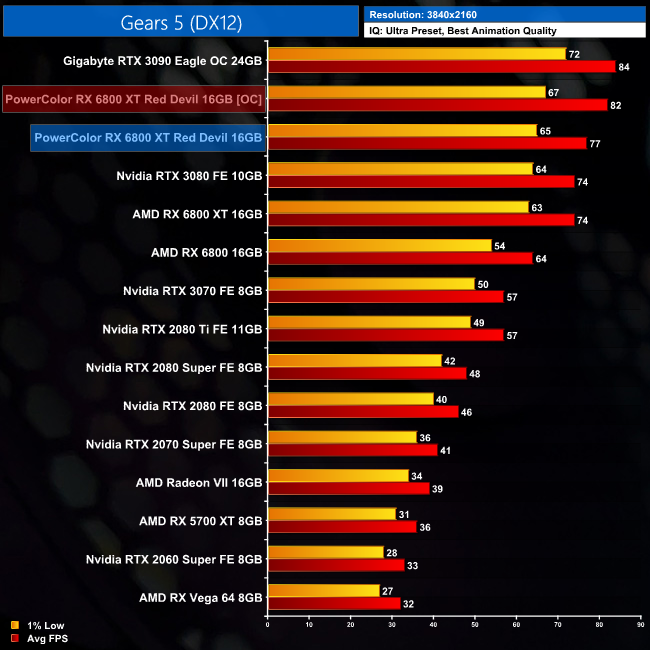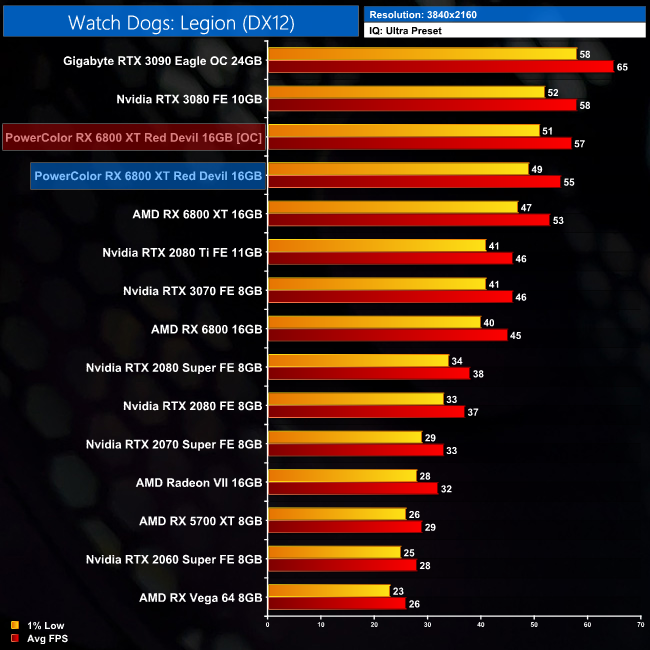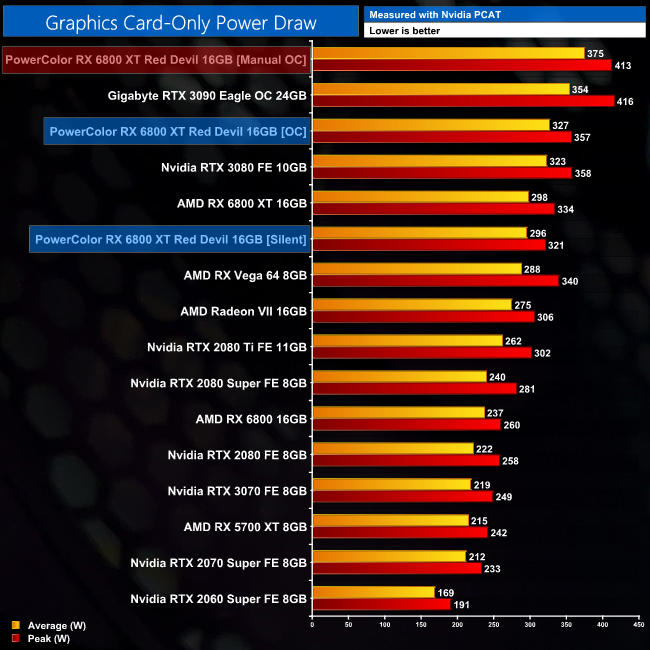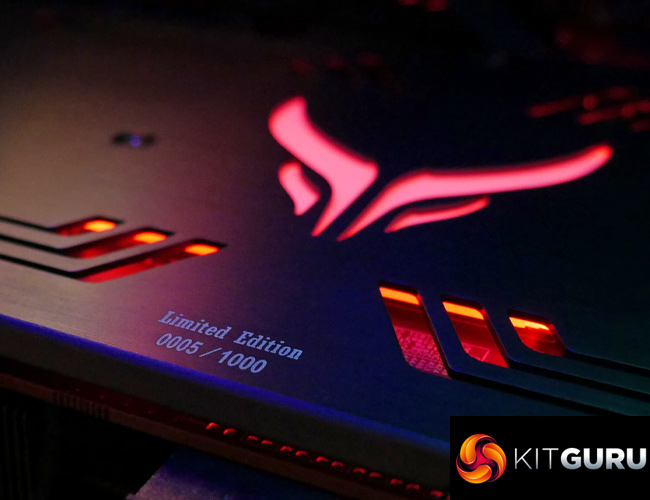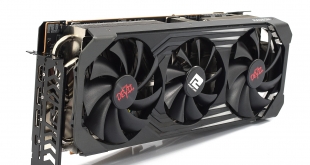
A week on from the launch of AMD's RDNA 2-based RX 6800 and RX 6800 XT GPUs, today we take a look at the first AIB model to come through our labs. The PowerColor RX 6800 XT Red Devil is a huge, triple-slot and triple-fan graphics card, with plenty of RGB lighting, a beefed-up VRM and dual-BIOS functionality. We put the Red Devil through its paces and see how it compares to AMD's reference design.
There is no doubt that the PowerColor RX 5700 XT Red Devil was one of the best aftermarket RX 5700 XT cards that we reviewed, delivering hugely significant improvements compared to AMD's reference blower-style cooler. That means expectations are fairly high for the RX 6800 XT Red Devil, and considering the sheer size of the thing, we are certainly looking for some thermal and acoustic improvements compared to the reference 6800 XT.
PowerColor has also sweetened the deal by adding a few extra features which the reference card lacks. There's RGB lighting on the underside, the end of the card and on the backplate, while there's the choice of either the OC or Silent BIOS, and PowerColor has even included an ARGB header to sync the RGB lighting via your motherboard. Factor in the enhanced power delivery, which PowerColor claims is able to deliver ‘well over' 400W, plus the factory overclocked core, and the Red Devil has all the ingredients to be a successful card. Let's find out whether or not that is the case.
| RX 6800 XT | RX 6800 | RX 5700 XT | RX 5700 | |
| Architecture | RDNA 2 | RDNA 2 | RDNA | RDNA |
| Manufacturing Process | 7nm | 7nm | 7nm | 7nm |
| Transistor Count | 26.8 billion | 26.8 billion | 10.3 billion | 10.3 billion |
| Die Size | 519 mm² | 519 mm² | 251 mm² | 251mm² |
| Ray Accelerators | 72 | 60 | n/a | n/a |
| Compute Units | 72 | 60 | 40 | 36 |
| Stream Processors | 4608 | 3840 | 2560 | 2304 |
| Game GPU Clock | Up to 2015MHz | Up to 1815MHz | Up to 1755MHz | Up to 1625MHz |
| Boost GPU Clock | Up to 2250MHz | Up to 2105MHz | Up to 1905MHz | Up to 1725MHz |
| Peak SP Performance | Up to 20.74 TFLOPS | Up to 16.17 TFLOPS | Up to 9.75 TFLOPS | Up to 7.95 TFLOPS |
| Peak Half Precision Performance | Up to 41.47 TFLOPS | Up to 32.33 TFLOPS | Up to 19.5 TFLOPS | Up to 15.9 TFLOPS |
| Peak Texture Fill-Rate | Up to 648.0 GT/s | Up to 505.2 GT/s | Up to 304.8 GT/s | Up to 248.4 GT/s |
| ROPs | 128 | 96 | 64 | 64 |
| Peak Pixel Fill-Rate | Up to 288.0 GP/s | Up to 202.1 GP/s | Up to 121.9 GP/s | Up to 110.4 GP/s |
| AMD Infinity Cache | 128MB | 128MB | n/a | n/a |
| Memory | 16GB GDDR6 | 16GB GDDR6 | 8GB GDDR6 | 8GB GDDR6 |
| Memory Bandwidth | 512 GB/s | 512 GB/s | 448 GB/s | 448 GB/s |
| Memory Interface | 256-bit | 256-bit | 256-bit | 256-bit |
| Board Power | 300W | 250W | 225W | 185W |
As a quick recap, here we can take a high-level overview of the Navi 21 GPU that forms the basis of the RX 6800 XT. While it is still fabricated on TSMC's 7nm process node, as per the RX 5000-series, Navi 21 sports a much larger GPU die, measuring 519 mm². For the RX 6800 XT, it houses 72 Compute Units (CUs), with 64 Stream Processors each, giving a grand total of 4608 shaders.
Rated clock speed has increased significantly for the RX 6000 series. The reference RX 6800 XT, for instance, has a rated game clock of 2015MHz and a rated boost clock of up to 2250MHz. The PowerColor Red Devil has increased this to 2090MHz and 2340MHz, respectively.
AMD has also increased the memory capacity, with 16GB of GDDR6 memory found on every RX 6000 SKU (so far). The memory is clocked at 16Gbps, and operates over a 256-bit memory interface for total bandwidth of 512 GB/s. AMD has also implemented a 128MB Infinity Cache on the Navi 21 GPU, to significantly increase effective memory bandwidth without excess power draw.
Speaking of power, the reference RX 6800 XT has a rated total board power (TBP) of 300W, though PowerColor has increased this for the Red Devil, as we will see later in this review.
The PowerColor RX 6800 XT Red Devil ships in a black box, with the Red Devil logo positioned right in the middle.
On the back, PowerColor highlights some key features of the GPU, as well as the minimum system requirements.
There's plenty of included accessories, but do note we have a sample of the limited edition, which comes with extra Red Devil-themed keycaps in the box, as well as a sticker and other pieces of documentation.
Looking at the graphics card itself, PowerColor is using a black plastic shroud with a few brushed metal plates screwed on top of the plastic. It's not as premium as an all-aluminium shroud (like the ASUS TUF RTX 3080) but it still feels solid in the hand.
Compared to the RX 5700 XT Red Devil, the overall design is slightly less aggressive and ‘flatter', whereas the last-gen card had a more angular and ‘in-your-face' appearance. The only bits of colour are the red Red Devil stickers on the two outer fans.
Speaking of the fans, the two outer ones measure 100mm across, whereas the central fan measures 90mm. For comparison, the 5700 XT model had 3x 90mm fans.
No doubt you will want to check this card can actually fit in your case before purchasing one, as this is a huge piece of kit. It measures 320 x 135 x 62mm, so it's a proper triple-slot thickness and measures well over 30cm long.
Definitely not intended for the mini-ITX market!
On the front side of the card, there's a couple of points worth noting. The first is the BIOS switch, and by default the card uses the OC BIOS, with a higher power target and clock speed compared to reference. There is also a Silent BIOS which drops the power target, clocks and fan speed. We test both of these modes later in the review.
The other thing worth noting is a 3-pin 5V ARGB header. PowerColor says this should allow the Red Devil's RGB lighting to be synchronised with a compatible motherboard, although during my testing I couldn't get ASUS Aura to recognise the GPU. It is possible a software update is needed to get this functioning properly, or I might have just been unlucky.
As for the backplate, this is a full-length aluminium plate in a dark/gunmetal grey colour, while there's plenty of cut-outs and ventilation for the back of the PCB. That Red Devil logo visible on the back is illuminated by RGB LEDs once powered on. We can also note our sample is listed as number 5 of 1000 limited edition units.
Speaking of the limited edition, PowerColor tells us the only real difference between this and the regular model are the display outputs – the limited edition has 1x HDMI 2.1, 2x DisplayPort 1.4, and 1x USB-C. The regular edition ditches the USB-C in favour of another DisplayPort. The main thing is that the card itself, the cooler and the PCB, is identical regardless of which version you get.
For power requirements, the Red Devil uses 2x 8-pin PCIe plugs.
In terms of the PCB, the Red Devil's board design is generally pretty similar to reference, but PowerColor has beefed things up slightly with a 16-phase VRM for the GPU, compared to the 13-phase design used for the reference card.
PowerColor is using International Rectifier TDA21472 MOSFETs, rated at 70A. The VRM controller is a 16-phase Infineon XDPE132G5D. For the memory, PowerColor is using a 3-phase solution, with an International Rectifier IR35217 controller. The memory modules themselves are supplied by Samsung, rated at 16Gbps.
As for the heatsink, it’s a very hefty unit, comprised of two separate finstacks. There’s a total of seven heatpipes, three of which measure 8mm in diameter, while the rest are 6mm. Both the GPU die and the GDDR6 memory contact with a plated copper baseplate, while there’s a separate plate that contacts with the VRM.
Lastly, we can see PowerColor is not using any thermal pads on the backplate to contact with the back of the PCB.
Driver Notes
- All Nvidia GPUs were benchmarked with the 457.09 driver.
- All AMD GPUs (except RX 6000) were benchmarked with the Adrenalin 20.11.1 driver.
- RX 6800 and RX 6800 XT were benchmarked with the Adrenalin 20.45.12.1 driver supplied to press.
Test System
We test using the a custom built system from PCSpecialist, based on Intel's latest Comet Lake-S platform. You can read more about it over HERE, and configure your own system from PCSpecialist HERE.
| CPU |
Intel Core i9-10900K
Overclocked to 5.1GHz on all cores |
| Motherboard |
ASUS ROG Maximus XII Hero Wi-Fi
|
| Memory |
Corsair Vengeance DDR4 3600MHz (4 X 8GB)
CL 18-22-22-42
|
| Graphics Card |
Varies
|
| System Drive |
500GB Samsung 970 Evo Plus M.2
|
| Games Drive | 2TB Samsung 860 QVO 2.5″ SSD |
| Chassis | Fractal Meshify S2 Blackout Tempered Glass |
| CPU Cooler |
Corsair H115i RGB Platinum Hydro Series
|
| Power Supply |
Corsair 1200W HX Series Modular 80 Plus Platinum
|
| Operating System |
Windows 10 2004
|
Comparison Graphics Cards List
- Gigabyte RTX 3090 Eagle OC
- Nvidia RTX 3080 FE 10GB
- Nvidia RTX 3070 FE 8GB
- Nvidia RTX 2080 Ti FE 11GB
- Nvidia RTX 2080 Super FE 8GB
- Nvidia RTX 2080 FE 8GB
- Nvidia RTX 2070 Super FE 8GB
- Nvidia RTX 2060 Super FE 8GB
- AMD RX 6800 XT 16GB
- AMD RX 6800 16GB
- AMD Radeon VII 16GB
- AMD RX 5700 XT 8GB
- AMD RX Vega 64 8GB
Software and Games List
- 3DMark Fire Strike & Fire Strike Ultra (DX11 Synthetic)
- 3DMark Time Spy (DX12 Synthetic)
- 3DMark Raytracing Feature Test (DXR Synthetic)
- Control (DX12)
- F1 2020 (DX12)
- Gears 5 (DX12)
- Ghost Recon: Breakpoint (Vulkan)
- Metro: Exodus (DX12)
- Red Dead Redemption 2 (Vulkan)
- Watch Dogs: Legion (DX12)
We run each benchmark/game three times, and present mean averages in our graphs. We use OCAT to measure average frame rates as well as 1% low values across our three runs.
Fire Strike is a showcase DirectX 11 benchmark for modern gaming PCs. Its ambitious real-time graphics are rendered with detail and complexity far beyond other DirectX 11 benchmarks and games. Fire Strike includes two graphics tests, a physics test and a combined test that stresses the CPU and GPU. (UL).
3DMark Time Spy is a DirectX 12 benchmark test for Windows 10 gaming PCs. Time Spy is one of the first DirectX 12 apps to be built the right way from the ground up to fully realize the performance gains that the new API offers. With its pure DirectX 12 engine, which supports new API features like asynchronous compute, explicit multi-adapter, and multi-threading, Time Spy is the ideal test for benchmarking the latest graphics cards. (UL).
Starting off our testing with 3DMark, the performance from the Red Devil is 4% faster than the reference RX 6800 XT across every test. That means it takes top spot in both Fire Strike and Fire Strike Ultra, while it comes second in Time Spy.
Real-time ray tracing is incredibly demanding. The latest graphics cards have dedicated hardware that’s optimized for ray-tracing. The 3DMark DirectX Raytracing feature test measures the performance of this dedicated hardware. Instead of using traditional rendering techniques, the whole scene is ray-traced and drawn in one pass. The result of the test depends entirely on ray-tracing performance. (UL).
For the DirectX Raytracing feature test, the Red Dvil manages 27.17 FPS, an increase of 5% compared to the reference 6800 XT, but it is still 8% behind the RTX 2080 Ti.
Control is an action-adventure video game developed by Remedy Entertainment and published by 505 Games. Control was released on 27 August 2019 for Microsoft Windows, PlayStation 4, and Xbox One. (Wikipedia).
Engine: Northlight Engine. We test using the High preset, with 4x MSAA, DX12 API.
For our game testing, we start with Control. At 4K, the Red Devil delivers 45FPS, an increase of just 2FPS compared to the reference card. This still works out as a 5% boost to the frame rate, but compared to the RTX 3080 Founders Edition, the Red Devil is 13% slower.
F1 2020 is the official video game of the 2020 Formula 1 and Formula 2 Championships developed and published by Codemasters. It is the thirteenth title in the Formula 1 series developed by the studio and was released on 7 July 2020 for pre-orders of the Michael Schumacher Edition and 10 July 2020 for the Seventy Edition on Microsoft Windows, PlayStation 4, Xbox One. (Wikipedia).
Engine: EGO. We test using the Ultra High preset, DX12 API.
As for F1 2020, here the Red Devil hits 125FPS on average when gaming at 4K, which is an increase of 5FPS compared to the reference card. This works out as a 4% boost, putting the PowerColor GPU within touching distance of the RTX 3080 Founders Edition.
Gears 5 is a third-person shooter video game developed by The Coalition and published by Xbox Game Studios for Xbox One, Microsoft Windows and Xbox Series X. It is the fifth installment of the Gears of War series and the sequel to Gears of War 4. The ultimate edition was released on September 6, 2019, while the standard edition of the game was released worldwide on September 10, 2019. (Wikipedia).
Engine: Unreal Engine 4. We test using the Ultra preset, with Best Animation Quality (instead of Auto), DX12 API.
Next up is Gears 5, and here the Red Devil's factory overclock is enough to take it 4% ahead of both the reference RX 6800 XT and Nvidia's RTX 3080 Founders Edition, with the PowerColor card delivering an extra 3FPS.
Tom Clancy's Ghost Recon Breakpoint is an online tactical shooter video game developed by Ubisoft Paris and published by Ubisoft. The game was released worldwide on 4 October 2019, for Microsoft Windows, PlayStation 4 and Xbox One, (Wikipedia).
Engine: AnvilNext 2.0. We test using the Ultra preset, with AA disabled, Vulkan API.
In Ghost Recon: Breakpoint, we see the smallest margin of increase for the Red Devil when compared to the reference card, across all of our games on test today. At 4K, the difference is just 3%, with the Red Devil averaging 61FPS.
Metro Exodus is a first-person shooter video game developed by 4A Games and published by Deep Silver in 2019. It is the third instalment in the Metro video game series based on Dmitry Glukhovsky's novels, following the events of Metro 2033 and Metro: Last Light. (Wikipedia).
Engine: 4A Engine. We test using the Ultra preset, but with Hairworks and Advanced PhysX turned off, DX12 API.
Next we come to Metro Exodus. Here, the Red Devil delivers 94FPS on average at 4K, another 4% improvement over the reference card. It also cuts the deficit when compared to the RTX 3080 to just 3%.
Red Dead Redemption 2 is a 2018 action-adventure game developed and published by Rockstar Games. The game is the third entry in the Red Dead series and is a prequel to the 2010 game Red Dead Redemption. Red Dead Redemption 2 was released for the PlayStation 4 and Xbox One in October 2018, and for Microsoft Windows and Stadia in November 2019. (Wikipedia).
Engine: Rockstar Advance Game Engine (RAGE). We test by manually selecting Ultra settings (or High where Ultra is not available), TAA, Vulkan API.
Red Dead Redemption 2 sees the Red Devil once more outpacing the reference RX 6800 XT by a 4% margin at 4K, though this is a difference of just 2FPS at this resolution.
Watch Dogs: Legion is a 2020 action-adventure game published by Ubisoft and developed by its Toronto studio. It is the third instalment in the Watch Dogs series, and the sequel to 2016's Watch Dogs 2. Legion was released on October 29, 2020 for Microsoft Windows, PlayStation 4, Xbox One, and Stadia. (Wikipedia).
Engine: Disrupt. We test using the Ultra preset, DX12 API.
Last but not least we have Watch Dogs: Legion. In this title, the Red Devil averages 55FPS at 4K, which works out as a 4% lead over the reference card. Compared to the RTX 3080 Founders Edition, it is 5% slower.
Here we present the average clock speed for each graphics card while running the 3DMark Time Spy stress test for 30 minutes. We use GPU-Z to record the GPU core frequency during the Time Spy runs. We calculate the average core frequency during the 30 minute run to present here.
Looking at the average clock speed of the Red Devil, it's no surprise to see the OC BIOS running faster than the Silent BIOS. The latter mode hits 2218MHz, while the OC BIOS is able to deliver an extra 82MHz. Both modes are faster than the reference design, which averaged 2173MHz.
Following on from our look at average GPU clock speed, here we present a series of charts, comparing the frequency response of the OC BIOS, the Silent BIOS, and the reference RX 6800 XT.
OC BIOS vs Silent BIOS
OC BIOS vs Reference
Silent BIOS vs Reference
OC BIOS GPU Frequency vs Temperature
Silent BIOS GPU Frequency vs Temperature
For our temperature testing, we measure the peak GPU core temperature under load. A reading under load comes from running the 3DMark Time Spy stress test for 30 minutes.
In terms of out of the box thermal performance, both BIOS provide reductions in edge temperature compared to the reference design, with the Silent BIOS peaking at 77C, compared to 73C for the OC BIOS due to its more aggressive fan curve. Against the reference card, those are reductions of 4C for the Silent BIOS and 8C for the OC BIOS. Both modes also reduce the junction temperature, which hit 98C for the reference card.
We take our noise measurements with the sound meter positioned 1 foot from the graphics card. I measured the noise floor to be 32 dBA, thus anything above this level can be attributed to the graphics cards. The power supply is passive for the entire power output range we tested all graphics cards in, while all CPU and system fans were disabled. A reading under load comes from running the 3DMark Time Spy stress test for 30 minutes.
For noise levels, we’ll start with the OC BIOS. This option sees the fans run at 45%, or 1350rpm, producing 38dBa on our noise meter, so it’s very easy on the ears. It is slightly louder than the reference card in this mode, but it’s also running faster with a higher power target.
As for the Silent BIOS, this drops fan speed down to 35%, or about 1060rpm. At this speed, the fans are effectively inaudible, and I am sure we would have actually seen a lower noise reading than 35dBa, were it not for a small amount of coil whine which was louder than the fan noise in this mode. In normal operation, this coil whine wasn’t noticeable over our system fans, but we obviously disable these for the noise tests, making the coil whine audible.
Following on from our stock thermal and acoustic testing, here we re-test the operating temperature of the GPU, but with noise levels normalised to 40dBa. This allows us to measure the efficiency of the overall cooling solution as varying noise levels as a result of more aggressive fan curves are no longer a factor.
For the noise-normalised temperatures, both BIOS modes again provide a reduction in operating temperature when compared to the reference card – at least when looking at edge temperature. The OC BIOS hit 68C with noise output configured to 40dBa (requiring a fan speed of 1570rpm, for those interested) while the Silent BIOS managed to reduce this by another 3C.
If you're wondering why the noise-normalised results are different between the two BIOS modes, despite the fact they obviously use the same cooler and are therefore running at the same fan speed, the answer is that the OC BIOS has a higher operating frequency and power target. Given both the Silent BIOS and the reference RX 6800 XT target 300W, this means comparing those two results is the most ‘apples to apples' comparison.
We measure system-wide power draw from the wall while running the 3DMark Time Spy stress test for 30 minutes.
Total system power draw shows a delta of about 40W between the OC and Silent BIOS, with the OC BIOS drawing more than the RTX 3080 Founders Edition.
We also use Nvidia PCAT to measure power draw of the graphics card only, with readings from both the PCIe slot and the PCIe power cables combined into a single figure. This provides us with significantly more accurate data to work with as it is measuring only the GPU power, and not total system power which is a fundamentally imprecise measurement.
More accurate data is found when looking at power draw of just the graphics card, for which we use Nvidia's PCAT. Here we can see the Silent BIOS averaged 296W under load, compared to 327W for the OC BIOS. The latter result is an extra 29W of juice compared to reference.
For our manual overclocking, we had more success with the Red Devil than the reference 6800 XT. We maxed out both the power limit slider and the memory frequency, while setting a minimum GPU frequency of 2450MHz and a maximum frequency of 2600MHz. In practice, this resulted in the GPU running between 2450 and 2550MHz.
Gains from this overclock varied slightly – up to 7% in F1 2020, but just 3% in Watch Dogs: Legion. Compared to the stock-clocked reference 6800 XT, though, the gains came in between 9-11%.
Power draw also rose by 15%, up to an average of 375W under load.
Following on from the launch of AMD's reference RX 6800 XT and RX 6800 GPUs, today sees the launch of the AIB cards from AMD's partners. We expect to analyse several of these over the coming weeks, but today our focus has been firmly on the PowerColor RX 6800 XT Red Devil.
PowerColor has deployed a beefed-up VRM for the Red Devil, enabling a 330W power target for the GPU, which is an increase of 30W compared to the reference spec. This allows the GPU to run a fair bit faster than AMD's reference card, and we saw it hovering about the 2300MHz mark during our testing.
This resulted in performance gains of 4% on average when testing our games at 4K, and 3% when looking at the 1440p results. This isn't a huge leap forward by any means, but gone are the days where a factory overclocked card would net you an extra 10%. With a 6800 XT, the Red Devil is doing well to deliver the speeds it does, but it will of course be interesting to see if any other partner cards can improve on this.
The Red Devil sports dual-BIOS, enabling users to choose between the OC BIOS with higher clocks and power draw, or the Silent BIOS which targets the same 300W limit as the reference design, but with slower fan speeds. It's a very successful dual-BIOS implementation, giving you the choice of maximum power, or minimum noise levels, while a secondary BIOS is also great for redundancy purposes.
Speaking of noise, the Silent BIOS runs the fans so slowly, at approximately 1060rpm, that they become effectively inaudible. The only downside here is that my particular sample exhibited a little bit of coil while which became audible once the fans were spinning so slowly. Were it not for this coil whine, I think we would have been looking at an even lower noise reading than the 35dBa recorded by our sound meter. The whine wasn't noticeable with the system fans running as normal though, so I can't complaint too strongly, but it is worth noting.
In terms of thermal performance, both the OC BIOS and Silent BIOS improve on the reference card. The Silent BIOS does run a little hotter than the OC BIOS, purely because it runs the fans so slowly, but when noise-normalised to 40dBa, it is the Silent BIOS which produces the best results due to its lower power target.
We also saw reasonable gains when manually overclocking. Considering the fact that the Red Devil is factory overclocked anyway, and we saw an extra 3-7% performance when pushing the GPU as far as it could go, I'd say that is a decent gain.
Unfortunately, from what we have been hearing from various retailers, it seems like stock is going to be very limited for the RX 6800 XT today. I don't hold this against PowerColor, but we weren't even able to get a confirmed UK price-point for the Red Devil. Both factors don't help when giving a final conclusion – we aim to offer buying advice, but if you simply cannot buy either this GPU or it's closest competitor, the RTX 3080, the waters become muddied.
What we can say is the PowerColor RX 6800 XT Red Devil is a solid improvement on the reference design. The relative difference between this card and AMD's reference may not be as big as we are used to seeing, but that's because AMD really upped its game for this generation and we no longer have to deal with a hot or loud blower-style cooler, which made it very easy to look good against in comparison.
Still, with its increased power target, factory overclocked core and dual-BIOS functionality, I'd take the Red Devil over the reference card any day of the week. We will just have to hope that pricing settles at a reasonable level once the supply issues are finally behind us.
Discuss on our Facebook page HERE.
Pros
- Choice of OC and Silent BIOS.
- OC BIOS allows for increased power.
- On average 4% faster at 4K, when using the OC BIOS.
- Silent BIOS runs the fans very slowly.
- Overclocked better than the reference card.
- Runs cooler than the reference card out of the box and when noise-normalised.
Cons
- Pricing is unclear.
- Slight coil whine is audible once the system fans have been disabled.
KitGuru says: The PowerColor RX 6800 XT is a great card and clearly improves on the reference design.
Be sure to check out our sponsors store EKWB here
 KitGuru KitGuru.net – Tech News | Hardware News | Hardware Reviews | IOS | Mobile | Gaming | Graphics Cards
KitGuru KitGuru.net – Tech News | Hardware News | Hardware Reviews | IOS | Mobile | Gaming | Graphics Cards



